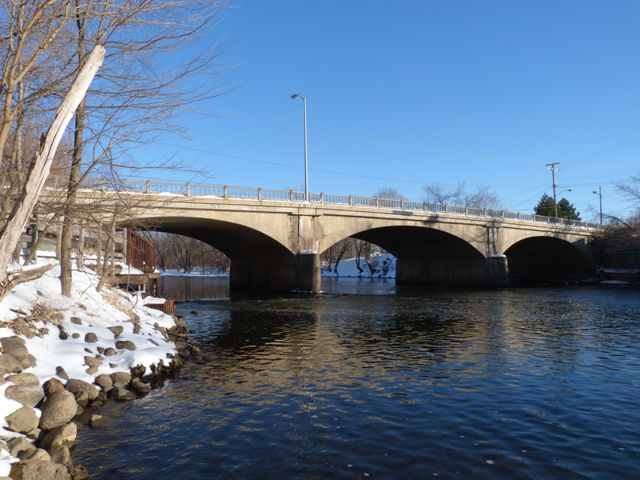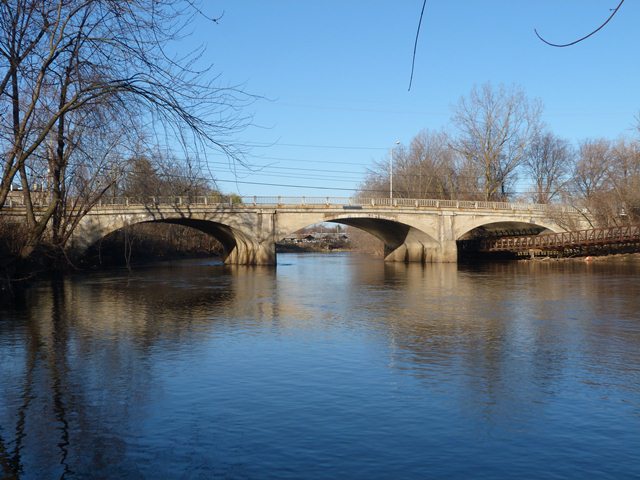We Recommend:
Bach Steel - Experts at historic truss bridge restoration.
BridgeHunter.com Phase 1 is released to the public! - Visit Now
North Grand River Avenue Bridge

Primary Photographer(s): Nathan Holth
Bridge Documented: March 2010, February 2011, November 25, 2011, and March 1, 2022
Lansing: Ingham County, Michigan: United States
2021
72.8 Feet (22.2 Meters)
205.0 Feet (62.5 Meters)
35.8 Feet (10.91 Meters)
3 Main Span(s)
334385000124B01

View Information About HSR Ratings
Bridge Documentation
The last remaining arch bridge in Ingham County and one of a shrinking number of multi-span arch bridges statewide, this bridge was rehabilitated, but with disappointing loss of its attractive R4 railings.
2010 Discussion of Bridge
The City of Lansing once had a number of concrete arch bridges including at least two that were eligible or listed in the National Register of Historic Places, and the city failed to preserve any of them. As a result, only this bridge remains in the city, and indeed all of Ingham County, as an example of this important structure type. Previously found ineligible for the National Register of Historic Places, the time has come to reconsider this bridge and recognize it as a locally significant example of its type. The bridge was built in 1924, and was altered at an unknown date, perhaps in the 1950s, with the replacement of its railings with Michigan's Type R4 railings. Although not original, the historical R4 railing type gives the bridge a beautiful appearance and compliments the arch design very nicely. The bridge remains in decent condition, and as such the City of Lansing has one last chance to make the right choice and preserve a historic concrete arch bridge. The value of preserving this bridge is clear, since a non-motorized walkway passes under the bridge on the northern side, and a park is also nearby, and as such the structure contributes to the beauty and features of these public facilities.
2022 Discussion of Bridge
The great news is Lansing did make the right choice by choosing to rehabilitate this historic bridge. They also get bonus points for demolishing a hideous Continental type modern pedestrian bridge that had been stuffed under the north span. However in looking at the bridge today one cannot help but think the city did not take full advantage of this opportunity to preserve a beautiful landmark. Indeed, people who simply drive over the bridge may assume this bridge has been demolished and replaced! Why? Because the beautiful R4 railings that defined Michigan bridge construction for decades were removed and replaced with a mundane modern railing that MDOT calls (quite inappropriately) the "aesthetic parapet tube." HistoricBridges.org remains confused as to what is "aesthetic" about two horizontal steel tubes placed above a solid concrete wall (parapet). The only "aesthetic" treatment are horizontal lines on the railing. A far cry from Michigan's signature R4 railings, which had their origins in the Art Deco era and continued to be proudly used in Michigan up until about 1963.
While the R4 railings were not original to this bridge, they were still beautiful and conveyed the history of Michigan, illustrating the rehab of an older arch bridge with R4 railings.
What could the city have done instead of replacing the railings? Several options were available.
The cheapest would have been to use an MDOT standard called the Thrie Beam Retrofit, which basically means adding double Armco guardrail in front of the railing. This does detract from the on-road experience as the R4 railing visibility would be reduced. However, the beside views of the bridge would have remained good.
For better results, a two steel tube design of guardrail could have been added in front for less obstruction. This was done with a historic bascule bridge in Cheboygan.
A third option would have been to add "Texas rail" which is a generic term (named after the state that pioneered this approach) that refers to a crash-tested concrete railing that resembles the balustrade railings used on old concrete bridges, indeed bridges like this very arch bridge! While adding these railings would have also resulted in the loss of the R4 railing, it would at least have harmonized with the historic design of the bridge, and perhaps might even hint at the original appearance of the bridge (the original railing on this bridge remains unknown).
As if three options are not enough, the city even had a 4th option! Near downtown, there is a bridge over the Grand River on Shiawassee Street. This bridge is a modern, non-historic bridge, but it replaced a historic concrete arch bridge and the engineers tried to hide this fact by adding fake arch fascias to cover the modern superstructure. In addition, this modern bridge, with no historic value, actually has concrete sidewalk railings (two tube railings for vehicular traffic) that have a true balustrade design and would have looked quite nice on this historic genuine concrete arch bridge.
Since the R4 railings have been lost, HistoricBridges.org recommends future work for this bridge to include removal of the "aesthetic parapet tube" railings with a Texas rail type of guardrail, or something resembling the Shiawassee Street railings. This is the best remaining option to make this bridge into a signature historic bridge crossing. Such work is not without precedent. In Mishawaka, Indiana, a concrete arch bridge had been altered with the installation of unpleasant looking metal railings, and during rehabilitation, a "Texas rail" was added. See this bridge's page for both before and after photos.
View Archived National Bridge Inventory Report - Has Additional Details and Evaluation

Above: The bridge as seen in 2022 after rehabilitation.
Above: Part of the MDOT standard, "Thrie Beam Retrofit," an option the City of Lansing could have used to preserve the R4 railing.

Above: Two tube retrofit of R4 railing on Cheboygan bascule bridge.

Above: Photos showing the modern railing system on the modern Shiawassee Street Bridge over Grand River in Lansing. This railing design would have looked very nice on the North Grand River Avenue Bridge, yet the city chose to use it on a modern bridge, and not a historic bridge!
This bridge is tagged with the following special condition(s): Unorganized Photos
![]()
Photo Galleries and Videos: North Grand River Avenue Bridge
Bridge Photo-Documentation
Original / Full Size PhotosA collection of overview and detail photos. This gallery offers photos in the highest available resolution and file size in a touch-friendly popup viewer.
Alternatively, Browse Without Using Viewer
![]()
Bridge Photo-Documentation
Mobile Optimized PhotosA collection of overview and detail photos. This gallery features data-friendly, fast-loading photos in a touch-friendly popup viewer.
Alternatively, Browse Without Using Viewer
![]()
Additional Unorganized Photos
Original / Full Size PhotosA supplemental collection of photos that are from additional visit(s) to the bridge and have not been organized or captioned. This gallery offers photos in the highest available resolution and file size in a touch-friendly popup viewer.
Alternatively, Browse Without Using Viewer
![]()
Additional Unorganized Photos
Mobile Optimized PhotosA supplemental collection of photos that are from additional visit(s) to the bridge and have not been organized or captioned. This gallery features data-friendly, fast-loading photos in a touch-friendly popup viewer.
Alternatively, Browse Without Using Viewer
![]()
Maps and Links: North Grand River Avenue Bridge
Coordinates (Latitude, Longitude):
Search For Additional Bridge Listings:
Bridgehunter.com: View listed bridges within 0.5 miles (0.8 kilometers) of this bridge.
Bridgehunter.com: View listed bridges within 10 miles (16 kilometers) of this bridge.
Additional Maps:
Google Streetview (If Available)
GeoHack (Additional Links and Coordinates)
Apple Maps (Via DuckDuckGo Search)
Apple Maps (Apple devices only)
Android: Open Location In Your Map or GPS App
Flickr Gallery (Find Nearby Photos)
Wikimedia Commons (Find Nearby Photos)
Directions Via Sygic For Android
Directions Via Sygic For iOS and Android Dolphin Browser
USGS National Map (United States Only)
Historical USGS Topo Maps (United States Only)
Historic Aerials (United States Only)
CalTopo Maps (United States Only)



